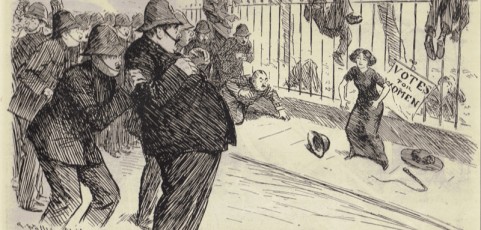One hundred years after the death of Emily Davison at the 1913 Derby, we look at the way leading suffragettes sought to galvanise support for their cause. “We were called militant, and we were quite willing to accept the name. We were determined to press this question of the enfranchisement of women to the point where we were no longer to be ignored by the politicians.” Emmeline Pankhurst, 1913. We recently ran an article examining the influence styles and techniques used in 10 famous speeches, showing how speakers attract an audience to their way of thinking by emphasising common ground, by sharing visions of a united future, by proposing, reasoning and persuading, and by maximising their impact through rhetorical devices such as three-part lists and contrasting pairs. Now, following the centenary of the most shocking occurrence in the history of the suffragette movement – the death of activist Emily Davison after she stepped in front of King George V’s horse at the Epsom Derby in 1913 – we look at the speeches, writings and street corner oratory from leading suffragettes and women’s rights campaigners in Britain and America. The late Victorian roots of the campaign for universal suffrage in Britain saw the growth of non-militant groups known as suffragists, who held meetings and sent petitions to Parliament. In 1897 they amalgamated into the National Union of Women’s Suffrage Societies, led by Millicent Fawcett, before Emmeline Pankhurst started the Women’s Social and Political Union with the motto ‘Deeds not words’ in 1903. Historians still debate whether the militant tactics ultimately helped or hindered the cause, but the influence of their words can still be felt a century later. Emmeline Pankhurst, ‘Freedom or death’ speech, 1913 Emmeline Pankhurst was an activist and leader of the British suffragette movement. Born and raised in Moss Side, Manchester, she was introduced to the concepts of the movement from a very early age by her politically active parents. The excerpts below come from a speech she delivered in Hartford, Connecticut, in November 1913. “I am not only here as a soldier temporarily absent from the field of battle. I am here—and that, I think, is the strangest part of my coming—I am here as a person who, according to the law courts of my country, it has been decided, is of no value to the community at all. And I am adjudged because of my life to be a dangerous person, under sentence of penal servitude in a convict prison. So you see, there is some special interest in hearing so unusual a person address you. I dare say, in the minds of many of you—you will perhaps forgive me this personal touch—that I do...
Critical Influence: The Rapid Response Toolkit
We recently ran an article on how to tackle a troubled work relationship via a 7-step influence planning process. But what to do when someone comes at you from out of the blue? Here’s the Positive Power & Influence Rapid Response Toolkit, for when you need to quickly and effectively influence a colleague on the warpath. Calming things down Your initial goal should be to bring down the temperature in the room through bridging and attracting behaviours – to listen, to guide the conversation by seeking clarification, to withhold your disagreements and highlight areas of agreement. 1. If someone is pushing you hard, move into a pull style ‘Ok so let me just check I understand where you’re coming from . . .’ ‘It sounds like you . . .’ Notes: If someone is on the attack, you can defuse some tension by showing that you are actively seeking to understand their position, by listening to what they say and inviting them to clarify their views. 2. Quickly find common ground ‘In the past we’ve worked well together on . . .’ ‘We both want this project to succeed . . .’ Notes: There may be issues of lack of trust or agreement that are causing the conflict. Don’t dwell on these initially, instead focus on where there is common ground – previous work together or a common goal. 3. If it isn’t working, be prepared to disengage Notes: If tensions are running too high, if there seems to be no room for negotiation, recognise this fact and clearly and decisively postpone the conversation to an agreed time and place. Understanding and reasoning Normally people are angry because they are not getting what they want. So you need to be clear about what they’re after. So, if someone says to you, “the thing is, I just don’t know where you stand on this issue,” they are very clearly inviting you to persuade, to explain your position. 4. If asked for your opinion, move into persuading Q: ‘I’d like to understand your opinion . . .’ A: ‘I think we should . . . My reasons are . . .’ Notes: In an unexpected pressure situation, you may not have all arguments prepared. But in the short term, try to focus on just one or two key points. Don’t water down your argument with less important factors that might easily be countered. 5. If you’re persuading and they’re not being influenced, ask what data they would need to see to be convinced ‘I’d really like you to agree to my proposal . . . What’s missing in my evidence?’ Changing course Alternatively, if the person says “I just...
Essential Influence: Selling Your Ideas
Blurting out ideas rarely leads to change, writes Nicola Lincoln. Resistance to new ways of doing things is a fact of organisational life and many logical innovations are lost in the rush of a working week. With a clear influence strategy, however, you’re much more likely to see your brainwave put into practice. 1. Asses your idea Begin by being honest with yourself. You need to take time to assess your idea as objectively as you can. Imagine someone else thought of it, and then constructively critique it. Ask yourself whether it can be improved or developed. Have you considered all the potential ramifications? 2. Identify stakeholders Who do you need to support your idea for it to be implemented? Put yourself in their shoes and ask what will they find most appealing about your idea, and what objections they might have. Figure out how you can avoid triggering concerns or resistance and plan to present your idea in the most favourable light possible to each stakeholder. You could also identify someone you trust, but who actively disagrees with the idea. Try to understand all their objections. 3. Find allies It’s time to assemble allies who could help persuade stakeholders to back the idea. Go first to people whose thinking you respect and whom you trust to listen to your idea with a favourable ear, or at least an open mind. Test your idea with your friends and confidants. Solicit their views and actively listen to what they say. If they like it, ask them to help you advance it. 4. Influence upward When you come to present your idea, it’s likely you will be attempting to influence someone who has higher positional power. Whenever you need to influence upward, clarity is key – keep your proposal clear and concise. Think about your target’s standpoint – what are their objections likely to be? Prepare for any roadblocks he/she may be likely to put in your way. You may need to use a blend of ‘push’ and ‘pull’ influence styles, and you should also be prepared to postpone, to disengage, if the conversation isn’t going in the direction you...





